I’ll admit the spring-time warblers confuse me just as much as the fall ones. Yes, they have much more vivid colouring at this time of year. Yes, they have unique songs. But when I see them, they seldom seem to be singing and they all seem to be sporting vivid patches of yellow, white and black. That’s where my camera helps me immensely. While I’m still gasping with surprise at the intensity of a yellow face or a ruby-copper horseshoe of colour around the edges of an underside, the camera is recording more details for later examination. Still, this year, one bird kept flitting its way into my viewfinder till I can finally recognize it quickly. So today, I’m introducing a Black Throated Green Warbler.
A Tale of Two Black Throated Warblers
At first, I couldn’t understand the logic of naming a warbler “Black Throated Green” when it has a chromium yellow face. The only green on it is a drab olive colour on the top of the head, back and the top of the wings. Yet it has vivid black and white streaks on the chest and zebra white wingbars on the black lower parts of the wings.
Then I met its counterpart, the Black Throated Blue Warbler.
The only similarity in appearance of the two males is the shiny black throat patch. However, probably back in olden times people were calling both types of birds Black Throats and so someone had to start differentiating them by adding “the ones with the blue backs” or “the ones with the green backs.”
Still, I think they could have come up with a better name for the Black Throated Green.
Will the Black Throated Green Warblers Stay in the GTA to Nest?
Some of the birds at the parks these days are busy building nests, defending territories and raising young. These include the hyperactive Yellow Warblers, some of the Catbirds, the Yellow Rumped Warblers, the Blue Grey Gnatcatchers, Orioles and Robins. And, as I just discovered this week, the American Woodcocks.
So I wondered if I should be looking for these lovely Black Throated Greens all summer or only for the few weeks in May when the migrants wash through.
According to the Cornell University website http://www.allaboutbirds.org/guide/black-throated_green_warbler/id they could nest here. That means I should keep an eye out for them in June and see if there’s a pair still about. They seem to like to feed in the tall cedar trees, which are covered in midges now but will be covered in mosquitoes later, so I might be able to see them.
When the deciduous trees leaf out, though, it always becomes a challenge. I never realized how many tree leaves are yellow till I started trying to find and focus on tree-top warblers.
Not Every Yellow-Faced, Zebra –Striped Bird is a Black Throated
I almost made the mistake of taking photos of “yet another” Black Throated Green this week. I’m glad I learned my lesson with the Mallard vs Wood Duck photo opp.
Because as you can see, this warbler isn’t the same. It’s yellow-throated not black. That’s because it’s a Blackburnian Warbler. So I made a mental note to myself: some yellow-orange on the face and vivid white wing bars with some black streaks on the sides of the chest is not enough to look for. It’s important to find that black throat: or that yellow one.
And it never hurts to take a photo of EVERY bird in the forest.
Related Reading
- When One Little Yellow Warbler Is Not “A” Yellow Warbler
- Magnolia Warblers Dart Into Fall in Mississauga
- Don’t Let the Green Head Fool You: That Duck in the Woods Isn’t a Mallard!
Join In
Do Black Throated Green Warblers sing near your home? Please share your sightings with a comment.


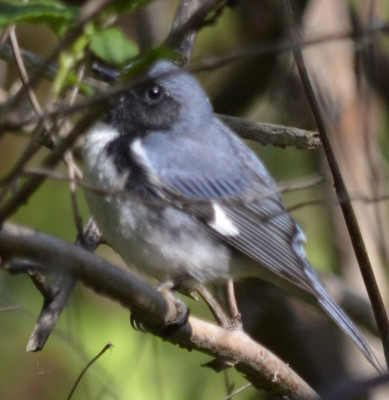
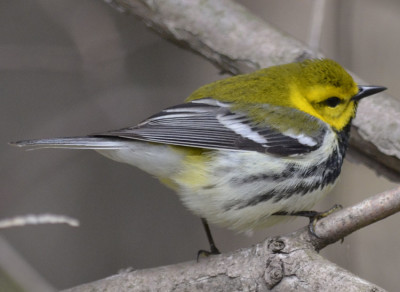
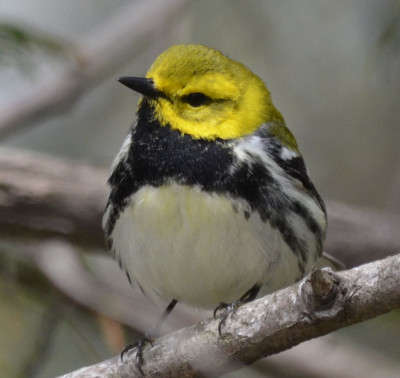
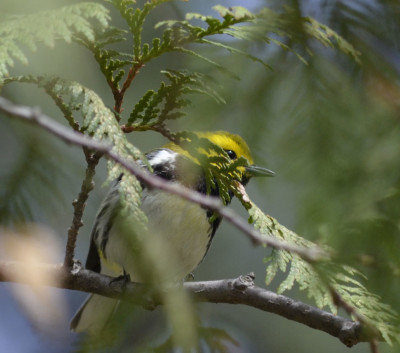
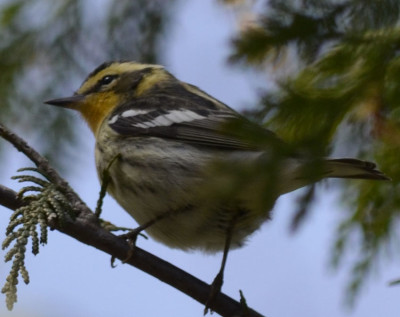
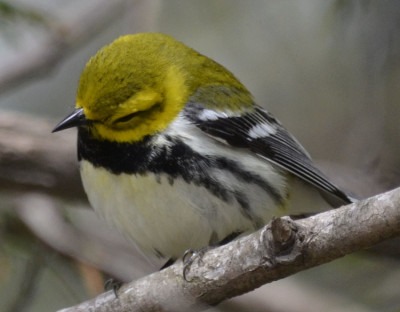
According to my field guide, Prothonotary Warblers do not come north of Lake Ontario — yet I am positive I saw a family of them in a grove of Locust trees yesterday. I got a number of photos of the birds, and used them to make my ID. Has anyone else seen these gorgeous birds in southern Ontario?
It depends where exactly in southern Ontario you mean. They do nest in places like Rondeau Provincial Park along Lake Erie. If you go to ebird.org and search by species, you can see where they have been reported. I’m not sure if this link will work or if it is too long:
http://ebird.org/ebird/map/prowar?neg=true&env.minX=&env.minY=&env.maxX=&env.maxY=&zh=false&gp=false&ev=Z&mr=1-12&bmo=1&emo=12&yr=all&byr=1900&eyr=2016
Another warbler that is a bit similar is the Blue-winged Warbler. They are slightly more widespread in southern Ontario.
eBird is a good place to check for sightings because it is more up to date than any of the books.
Thanks for sharing your experience.
Just got my first photo of one. I live in Broward County (South Florida). Great post, it helped me identify this bird, Thank you.
I’m glad you got to see and photograph a gorgeous warbler!
A great website for identifying birds, especially ones with “look a likes” is the Cornell University, AllAboutBirds site.
Good luck with future photos!